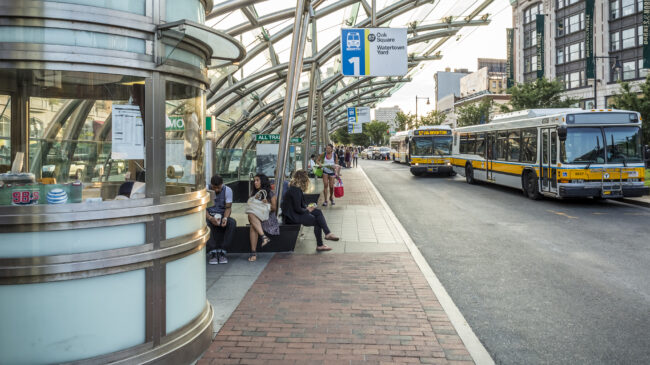On behalf of Reason Foundation, I respectfully submit these comments in response to the Office of the Secretary of Transportation’s (“OST”) Request for Information on Transportation Equity Data (“RFI”).
Reason Foundation is a national 501(c)(3) public policy research and education organization with expertise across a range of policy areas, including transportation. This comment letter discusses research responsive to the RFI and encourages OST to consider job access across transportation modes as an important transportation equity measure.
Access to Automobiles and Equity
During the 1960s, economist John Kain developed what came to be known as the spatial mismatch hypothesis. Kain and others suspected that advances in transportation technology and resulting changes in firm and household location choice affected labor markets in a way that particularly disadvantaged African Americans. Employment growth that increasingly clustered in auto-oriented suburbs was leaving behind Black metropolitan area workers who continued to disproportionately reside in carless households located in central cities.
The magnitudes of both spatial mismatch generally and automobile access specifically on employment outcomes are still being debated, but the broad consensus is that spatial mismatch is real and that disparity in car access explains some of the diminished labor market outcomes observed in underserved communities. Notable studies on these questions have found:
- The differences in the number of cars per adult household member account for 43 percent of the Black-white employment disparity and 19 percent of the Latino-white employment disparity.
- The successful job search completion gap between white and Black workers would be reduced by 8 percent if Black workers had the same car ownership rates as their white counterparts.
- Among single mothers, car ownership often doubles the probability of employment and results in large increases in the number of hours worked per week.
- Car ownership is a significant predictor of employment (positive) and welfare use (negative).
- Auto access significantly reduced poverty exposure among participants of a Department of Housing and Urban Development housing assistance program.
Fortunately, auto ownership rates have been converging between disadvantaged communities and the national average for decades. In the case of racial and ethnic minorities, this trend has been pronounced. In 1970, the percent of all households with zero cars available stood at 17.5 percent, but 43.1 percent of African-American households lacked access to a car at that time—a gap of 25.6 percent. By 2018, that had fallen to 8.5 percent and 18.1 percent, respectively—a gap of 9.6 percent.
Hispanic households have also seen strong gains, with 21.8 percent lacking vehicles in 1980 (and a gap of 8.9 percent) to just 10.6 percent lacking vehicles in 2018 (with a gap of 2.1 percent). If household access to automobiles continues to rise and this gap continues to narrow, the expectation is that spatial mismatch’s importance in labor market outcomes will similarly decline.
Access to Jobs Varies Greatly by Mode of Transportation
For those relatively few Americans who continue to rely on mass transit, transit system performance in connecting people with places leaves much to be desired. The University of Minnesota’s Access Across America series shows that in 2019, those residing in the 50 largest U.S. metro areas could on average access 47 percent of metro area jobs by car in 30 minutes of travel (or one hour of bidirectional daily commuting).
In contrast, just 8 percent of jobs were accessible by transit in 60 minutes (or two hours of bidirectional daily commuting). Even in the New York City metro area, by far the most transit-oriented American metro area, and where more than 40 percent of total U.S. transit trips take place, drivers can access 13 percent of New York metro area jobs in 30 minutes versus just 14 percent of jobs accessible in 60 minutes by transit.
New York City, and especially Manhattan, offers the lowest penalty for zero-vehicle households. The city contains 15 percent of America’s zero-vehicle households despite accounting for just 3 percent of the national population. Some urban planners and mass transit advocates suggest the goal should be recreating the Manhattan-style built environment in as many places as possible. But even assuming this is a worthy goal, it fails to address the aforementioned disparities that exist today.
As urban planners David A. King, Michael J. Smart, and Michael Manville concluded in a 2019 article in the Journal of Planning Education and Research, “This goal, however, while undeniably important, is also indisputably long-term, and pursuing it offers little help to transportation-poor households today. For this reason, the long-range goal of helping most non-poor Americans drive less needs to be paired with a shorter-range goal of helping some poorer Americans drive more.”
When the pandemic struck and people understandably feared sharing crowded spaces with strangers, mass transit ridership collapsed by 95 percent at its worst. By the end of 2020, transit ridership remained approximately two-thirds below its pre-pandemic level. Transit may never recover to pre-pandemic travel volumes, but bus transit that tends to serve lower-income people has rebounded much more than rail transit, which increasingly serves affluent professionals in central business districts who are likely to continue working at home in large numbers. Policymakers should prepare for likely post-pandemic changes in the transit landscape.
The COVID-19 pandemic worsened transit’s already negative outlook, where transit’s pre-pandemic national market share stood at only 2.6 percent of total person trips and 5 percent of commuting trips. Contrary to claims that transit has been chronically underfunded, transit was already receiving nearly 30 percent of total federal, state, and local spending on highways and transit, according to the Congressional Budget Office.
As economists Gilles Duranton, Geetika Nagpal, and Matthew Turner wrote in a 2020 working paper for the National Bureau of Economic Research, “The allocation of expenditure across modes of transportation requires scrutiny. That we spend about the same amount on public transit buses, which provide about 2 billion rides per year, as on the interstate highway system, which provides about 700 billion miles of vehicle travel per year, primarily for local travel, is a central and surprising feature of US transportation policy.”
Conclusion
OST should consider job access by mode as an important equity measure. OST should also contemplate the likelihood that policies perpetuating transit dependence and limiting auto access may also perpetuate unemployment and poverty, particularly among disadvantaged communities who still experience reduced automobile access and resulting benefits relative to the national average.

